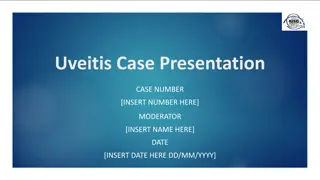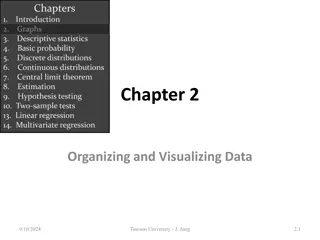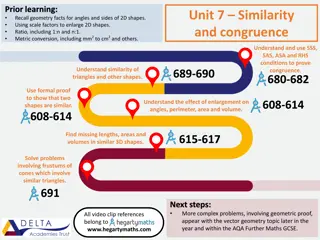Understanding Filesystems: A Comprehensive Overview
File systems provide a structured approach to storing and organizing data on secondary storage devices. They involve logical organization of files, directories for grouping related files, sharing data between users, and managing permissions. Files contain data with attributes like size, ownership, and permissions, while directories help in organizing files and mapping file names to data. File meta-data includes additional information like file type, location on disk, and ownership details. Directories are files containing metadata about other files and can be implemented in various ways like linear lists or balanced trees for efficient file management.
Download Presentation

Please find below an Image/Link to download the presentation.
The content on the website is provided AS IS for your information and personal use only. It may not be sold, licensed, or shared on other websites without obtaining consent from the author. Download presentation by click this link. If you encounter any issues during the download, it is possible that the publisher has removed the file from their server.
E N D
Presentation Transcript
File Systems In general file systems are simple Abstraction for secondary storage Files Logical organization of files Directories Sharing of data between users/processes Permissions/ACLs
Files Collection of data with some properties Contents, size, owner, permissions Files may also have types Understood by file system Device, directory, symbolic link, Understood by other parts of OS/runtime Executable, DLL, source code, object code, Types can be encoded in name or contents File extension: .exe, .txt, .jpg, .dll Content: #!<interpreter> Operating system view Bytes mapped to collection of blocks on persistent physical storage
Directories Provides: Method for organizing files Namespace that is accessible by both users and FS Map from file name to file data Actually maps name to meta-data, meta-data maps to data Directories contain files and other directories /, /usr, /usr/local, Most file systems support notion of a current directory Absolute names: fully qualified starting from root of FS /usr/local (absolute) Relative names: specified with respect to current directory ./local (relative)
File Meta-Data Meta-Data: Additional information associated with a file Name Type Location of data blocks on disk Size Times: Creation, access, modification Ownership Permissions (read/write) In unix, the data representing a file is called an inode (for indirect node) Inodes contain file size, access times, owner, permissions Inodes contain information on how to find the file data (locations on disk) Every inode has a location on disk.
Directory entries A directory is a file (inode) that contains only meta-data Directory = list of (name of file, file attributes) Attributes include: Size, protection, location on disk, creation time, List is usually un-ordered (effectively random) Running ls sorts files in memory
Directory Implementation A directory is a file containing name metadata about file (Windows) size owner data locations Pointer to file metadata (Unix) Organization Linear list of file names with pointer to the data blocks simple to program time-consuming to execute BTree balanced tree sorted by name Faster searching for large directories
Unix directory files A directory is a flat file of fixed size entries Each entry consists of an inode # and a file name
Directory Trees Directory entries specify files But a directory is a file Special bit in meta-data stored in directory entry User programs can read directories But, only system programs can write directories Why is this true? Special directories This directory: . Parent directory: .. Root: / Fixed directory entry for its own meta-data
Workloads Workloads provide design target of a system Common file characteristics Most files are small (~8KB) Large files use most of disk space 90% of data is used by 10% of files Access Patterns Sequential: Files read/written in order Most common Random: Access block without referencing predecessors Locality based: Files in same directory accessed together Relative access: Meta-data accessed first to find data
Allocation Strategies Progression of approaches Contiguous Extent based Linked File-Allocation Tables Indexed Multi-level indexed Issues Amount of fragmentation (internal and external) Ability of file to grow over time Seek cost for sequential accesses Speed to find data blocks for random accesses Wasted space to track state
Contiguous Allocation Allocate each file to contiguous blocks on disk Meta-data includes first block and size of file OS allocates single chunk of free space Advantages Low overhead for meta-data Excellent sequential performance Simple to calculate random addresses Disadvantages Horrible external fragmentation (requires compaction) Usually must move entire file to resize it
Extent Based Allocation Allocate multiple contiguous regions (extents) Meta-data: Small array of extents (first block + size) D D A A A D B B B B C C C D D Improves contiguous allocation File can grow over time External fragmentation reduced Advantages Limited overhead for meta-data Good performance with sequential accesses Simple to calculate random addresses Disadvantages External fragmentation can still be a problem Extents can be exhausted (fixed size array in meta-data)
Linked Allocation Allocate linked-list of fixed size blocks Meta-data: location of file s first block Each block stores pointer to next block D D A A A D B B B B C C C B B D B D Advantages No External fragmentation File size can be very dynamic Disadvantages Random access takes a long time Sequential accesses can be slow Can try to allocate contiguously to avoid this Very sensitive to corruption
File Allocation Table (FAT) Variation of Linked Allocation Linked list information stored in FAT table (on disk) Meta-data: Location of first block of file Comparison to Linked Allocation Same basic advantages and disadvantages Additional disadvantage: Two disk reads for 1 data block Optimization: Cache FAT table in memory
File-Allocation Table Directory Entry File Allocation Table Data blocks Name Foo.txt Meta-Data Meta-Data Start Block 23 632 Block 23 Name Name Name Meta-Data Meta-Data Meta-Data Start Block Start Block Start Block NULL Block 317 317 Block 632
Indexed Allocation Allocate fixed-size blocks for each file Meta-data: Fixed size array of block pointers Array allocated at file creation time Advantages No external fragmentation Files can be easily grown, with no limit Supports random access Disadvantages Large overhead for meta-data Unneeded pointers are still allocated
Multi-level Index Files Variation of Indexed Allocation Dynamically allocate hierarchy of pointers to blocks as needed Meta-data: Small number of pointers allocated statically Allocate blocks of pointers as needed Comparison to Indexed Allocation Advantage: Less wasted space Disadvantage: Random reads require multiple disk reads
Free Space Management How do you remember which blocks are free Operations: Free block, allocate block Free List: Linked list of free blocks Advantages: Simple, constant time operations Disadvantage: Quickly loses locality Bitmap: Bitmap of all blocks indicating which are free Advantages: Can find sequence of consecutive blocks Disadvantage: Space overhead
UNIX File System Implemented as part of original UNIX system Ritchie and Thompson, Bell Labs, 1969 Designed for workgroup scenario Multiple users sharing a single system Still forms the basis of all UNIX based file systems
5 parts of a UNIX Disk Boot Block Contains boot loader Superblock The file systems header Specifies location of file system data structures inode area Contains descriptors (inodes) for each file on the disk All inodes are the same size Head of the inode free list is stored in superblock File contents area Fixed size blocks containing data Head of freelist stored in superblock Swap area Part of disk given to virtual memory system
So With a boot block you can boot a machine Stores code for boot loader With a superblock you can access a file system Superblock always kept at a fixed location Specifies where you can find FS state information By convention root directory ( / ) is stored in second inode Most current boot loaders read superblock to find kernel image
Inode format User and group IDs Protection bits Access times File Type Directory, normal file, symbolic link, etc Size Length in bytes Block list Location of data blocks in file contents area Link Count Number of directories (hard links) referencing this inode
Unix Filesystem (Inodes) Metadata Ownership, permissions Access/Modification times etc Direct blocks: Array of consecutive data blocks Block size = 512 bytes Inlined in the inode Indirect blocks: i-node only holds a small number of data block pointers (direct pointers) For larger files, i-node points to an indirect block containing 1024 4-byte entries in a 4K block Each indirect block entry points to a data block Can have multiple levels of indirect blocks for even larger files
Hierarchical File Systems Directory is a flat file of fixed size entries Each entry consists of an inode number and file name Inode Number Filename 152 . 18 .. 216 My_file 4 Another file 93 Dir_3
Unix Inodes and Path Search Unix Inodes are not directories Inodes describe where on disk a file s blocks are stored Directories are files Inodes describe where a directory s blocks are stored Directory entries map file names to inodes To open /foo , use Master Block to find inode for / Open / , search for entry foo This entry specifies block number for inode of foo Read foo s inode into memory Get first data block location from inode Read block into memory
FS characteristics Only occupies 15 x 4bytes in inode Can get to 12 x 4KB (48KB) of data directly Very fast accesses to small files Can get to 1024 x 4KB (4MB) with a single indirection Reasonably fast access to medium files Can get to 1024 x 1024 x 4KB (4GB) with 2 indirections Maximum file size is 4TB with 3 indirections
Consistency Issues Both Inodes and file blocks are cached in memory sync command forces a flush of all disk info in memory System forces sync every few seconds System crashes between sync points can corrupt file system Example: Creating a file 1. Allocate an inode (remove from free list) 2. Write inode data 3. Add entry to directory file What if you crash between 1 and 2?























